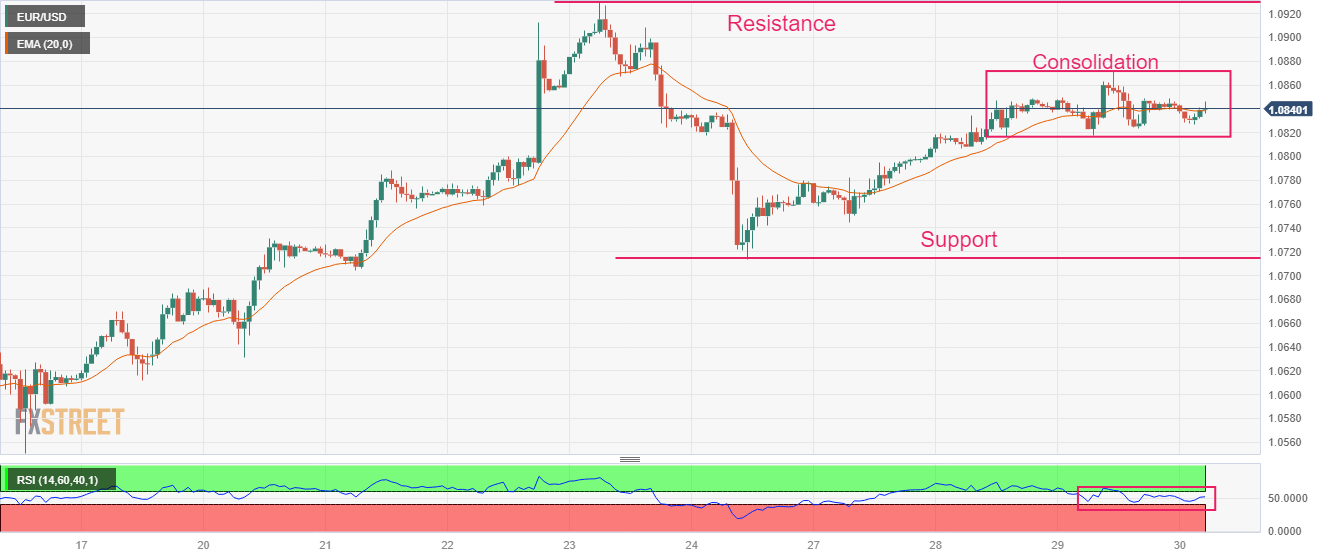EUR/USD approaches 1.0850 as USD’s upside impulse fades despite easing dovish Fed bets
- EUR/USD is marching towards 1.0850 as the upside momentum in the USD Index has faded.
- Federal Reserve Powell has anticipated one more interest rate hike this year.
- European Central Bank may continue to raise rates further but at a slower pace.
- EUR/USD is consolidating in a narrow range of 1.0818-1.0871 ahead of the German Inflation data.
EUR/USD is looking to stretch its recovery towards the immediate resistance of 1.0850 in the early European session. The major currency pair rebounded from 1.0830 as US Dollar Index (DXY) retreated amid positive market sentiment. A volatile action is highly expected from the shared currency pair ahead of the German Harmonized Index of Consumer Prices (HICP) data.
S&P500 futures have recovered their entire losses posted in the Asian session and have turned positive as investors are cheering receding fears of United States banking jitters. Acquisition of collapsed Silicon Valley Bank’s (SVB) deposits and advances and now discussion over increasing insurance limits for deposits have infused immense confidence in investors that US authorities are taking care of the overall financial system.
The demand for US government bonds is easing further amid anticipation of one more interest rate hike by Fed chair Jerome Powell and ebbing banking turmoil fears, which have raised 10-year US Treasury yields further to 3.59%.
USD Index loses momentum despite easing dovish Federal Reserve bets
The USD Index has shown a decent correction after failing to extend its upside journey to the critical resistance of 103.00. It looks like the USD Index has failed to capitalize on easing dovish Federal Reserve (Fed) bets after Federal Reserve chair Jerome Powell anticipated one more rate hike in 2023. As per the CME Fedwatch tool, chances of an unchanged monetary policy in May have trimmed quickly to 50%.
In March’s monetary policy meeting, Federal Reserve Powell also stated that one more rate hike is still needed after pushing rates to 4.75-5.00%. The discussion looks encouraging about the month when Federal Reserve Powell will put the last nail in the coffin.
For further clarity, US core Personal Consumption Expenditure (PCE) Price Index data will be keenly watched, which will release on Friday. As per the consensus, monthly core PCE would accelerate by 0.4%, lower than the former expansion of 0.6%. The annual figure is expected to remain steady at 4.7%.
Fears of US banking crisis receded further
US authorities have put their blood and sweat into restoring the confidence of investors in the troubled banking system after the collapse of three mid-size banks. The administration is not considering an expansion of blanket insurance for all deposits but has come forward with more measures.
Bloomberg reported that the private meeting between Federal Reserve Powell and US lawmakers has also discussed the agenda of raising insurance limits for deposits after the collapse of Silicon Valley Bank (SVB) and Signature Bank. Currently, the Federal Deposit Insurance Corporation (FDIC) currently insures up to $250,000 per depositor.
On Wednesday, Federal Reserve (Fed) Vice Chair for Supervision Michael Barr told Senate Banking Committee that the United States banking system is ‘sound and resilient’. He assured investors that the failure of a couple of lenders is unable to lead to a widespread contagion.
German Inflation remains the key
Financial instability inspired by global banking jitters in Eurozone has raised concerns about a further escalation in interest rates by the European Central Bank (ECB). ECB policymaker Peter Kazimir cited on Wednesday “I think inflation is too high for too long.” He further added that the European Central Bank will consider the financial situation before arriving at the interest rate decision. ECB Kazimir believes “There is a genuine danger that banks will cut back on lending.”
About interest rate guidance, ECB Kazimir is of the view, “We should continue in raising rates, possibly at a slower pace.”
It seems that German HICP data will deliver more clarity about the monetary policy outlook. The street is anticipating monthly German HICP to expand by 0.8% vs. the former release of 1.0%. On an annual basis, German HICP would soften dramatically to 7.5% from the prior release of 9.3%.
EUR/USD technical outlook

EUR/USD is showing immense contraction in volatility ahead of the German inflation data. The shared currency pair is consolidating in a narrow range of 1.0818-1.0871 on an hourly scale. The downside of the major is supported near March 24 low at 1.0714 while the upside is restricted near March 23 high at 1.0930.
The 20-period Exponential Moving Average (EMA) at 1.0840 has overlapped the asset, which indicates a rangebound structure.
Also, the Relative Strength Index (RSI) (14) is oscillating in the 40.00-60.00 range, which indicates that investors are awaiting a fresh trigger for a decisive move.
